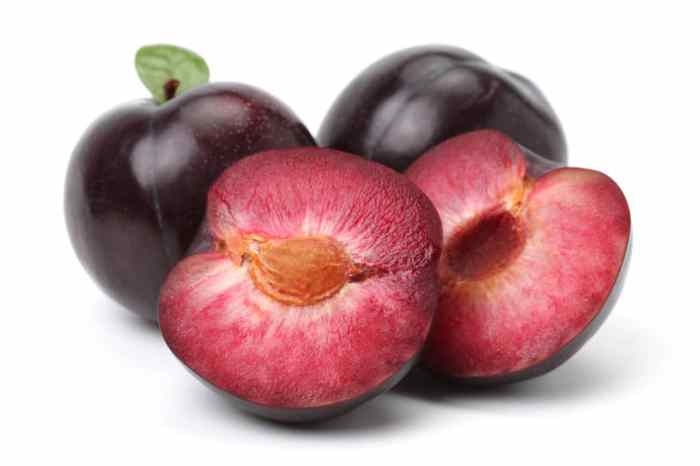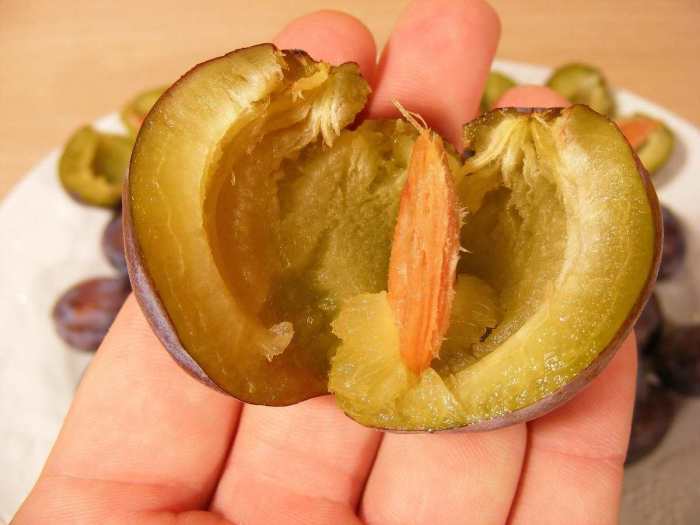Can You Plant a Plum Seed?
Plum Seed Viability
Can you plant a plum seed – Successfully growing a plum tree from seed hinges on understanding plum seed viability and employing effective germination techniques. Several factors influence the germination rate, and preparing the seeds appropriately significantly improves your chances of success.
Factors Affecting Plum Seed Germination
The germination rate of plum seeds is influenced by several key factors. Seed maturity at harvest is crucial; seeds from fully ripened plums generally exhibit higher viability. Storage conditions also play a significant role. Improper storage can lead to seed deterioration and reduced germination rates. Finally, the presence of a hard seed coat can hinder water uptake and germination, necessitating techniques like scarification or stratification.
Seed Stratification for Improved Germination
Plum seeds require a period of cold stratification to mimic the natural winter conditions they would experience in their environment. This process breaks down the seed coat’s dormancy and promotes germination. To stratify plum seeds, place them in a moist medium (e.g., vermiculite, peat moss) in a sealed container and refrigerate at temperatures between 33-40°F (0-4°C) for 60-90 days.
Regularly check the moisture level, ensuring it remains consistently moist but not soggy.
Germination Rates: Fresh vs. Dried Seeds
Freshly harvested plum seeds generally exhibit higher germination rates compared to dried seeds. Drying can significantly reduce seed viability, affecting the ability of the seed to germinate. Ideally, plant plum seeds as soon as possible after harvesting to maximize your chances of success.
Testing Seed Viability
Before planting, testing seed viability helps determine the proportion of seeds likely to germinate. A simple method involves soaking the seeds in water for 24 hours. Seeds that sink are generally considered viable, while those that float are likely non-viable and should be discarded. A more precise method involves using a germination test, planting a sample of seeds under ideal conditions and monitoring their germination rate.
Planting Methods
Plum seeds can be planted directly into the ground or started indoors in containers. Each method has its advantages and disadvantages, influencing the timing and effort involved in establishing young plum trees.
Direct Sowing of Plum Seeds
Direct sowing involves planting plum seeds directly into the prepared soil outdoors. Begin by selecting a suitable location with well-drained soil and adequate sunlight. Prepare the planting area by loosening the soil and removing any weeds. Plant seeds at a depth of approximately ½ inch, spacing them 1-2 feet apart. Maintain consistent soil moisture until germination occurs.
Starting Plum Seeds Indoors
Starting plum seeds indoors allows for more control over the germination environment. Use small pots or seed trays filled with a well-draining seed-starting mix. Plant seeds at a depth of approximately ½ inch and maintain consistently moist soil. Provide adequate light, either through a sunny windowsill or grow lights. Once seedlings develop several true leaves, they can be transplanted outdoors.
Direct Sowing vs. Indoor Starting
| Method | Pros | Cons | Suitable For |
|---|---|---|---|
| Direct Sowing | Simpler, less labor-intensive | Lower germination rate, susceptible to environmental conditions | Warm climates, experienced gardeners |
| Indoor Starting | Higher germination rate, better control over environment | More time-consuming, requires more resources | All climates, beginners |
Ideal Depth and Spacing for Plum Seeds
The illustration depicts planting plum seeds at a depth of approximately ½ inch (1.27 cm), spaced 1-2 feet (30-60 cm) apart. This spacing ensures adequate room for root development and minimizes competition for resources. The seeds should be placed in a well-drained soil bed, ensuring proper moisture retention without waterlogging.
Soil and Environmental Conditions
Optimal soil conditions and a suitable environment are crucial for successful plum tree growth from seed. Understanding the specific requirements for soil type, pH, sunlight, water, and addressing potential environmental challenges are essential for maximizing success.
Ideal Soil Type and pH
Plum trees thrive in well-drained, loamy soil with a slightly acidic to neutral pH (6.0-7.0). Heavy clay soils should be amended with organic matter to improve drainage and aeration. Sandy soils may require the addition of organic matter to improve water retention.
Sunlight and Water Requirements

Source: garden.eco
Plum trees require at least 6-8 hours of direct sunlight per day for optimal growth and fruiting. Consistent watering is essential, especially during dry periods, but avoid overwatering, which can lead to root rot. Maintain evenly moist soil, allowing the top inch or two to dry slightly between waterings.
Environmental Challenges and Mitigation
- Pests: Aphids, plum curculio, and other insects can damage plum trees. Regular monitoring and the use of appropriate insecticides or organic pest control methods are crucial.
- Diseases: Brown rot, plum pockets, and other fungal diseases can affect plum trees. Proper sanitation, disease-resistant varieties, and fungicide applications can help prevent or manage these issues.
- Frost: Frost can damage young plum trees. Protection with covers or relocation to a sheltered location during frost events is important.
Suitable Planting Location
The ideal location for planting a plum seed should receive ample sunlight (at least 6-8 hours daily), have well-drained soil to prevent waterlogging, and offer some protection from strong winds. A slightly sloped area can further enhance drainage. Consider the mature size of the tree when selecting a location, ensuring it has sufficient space to grow without overcrowding.
Care and Maintenance
Providing consistent care and maintenance is crucial for the healthy growth and development of young plum seedlings. This includes regular watering, fertilization, weed control, and protection from environmental stressors.
Yes, you can plant a plum seed, though it’s a lengthy process to get a fruiting tree. Timing is key, much like knowing when to plant other seeds, such as wildflowers; for Pennsylvania residents, a helpful resource is this guide on when to plant wildflower seeds in pa. Understanding seasonal planting helps ensure success, whether you’re growing plums or wildflowers.
Patience is vital when planting plum seeds, just as it is for most garden endeavors.
Watering, Fertilization, and Weed Control, Can you plant a plum seed
Water young plum seedlings regularly, keeping the soil consistently moist but not waterlogged. Apply a balanced fertilizer according to package instructions, typically during the growing season. Regularly remove weeds to reduce competition for nutrients and water.
Protection from Extreme Weather

Source: agrifarming.in
Protect young plum seedlings from extreme weather conditions such as frost, strong winds, and intense sun. Use covers, windbreaks, or shade cloth as needed.
Preventative Measures Against Pests and Diseases
Regularly inspect seedlings for signs of pests and diseases. Implement preventative measures such as proper sanitation, disease-resistant varieties, and timely applications of appropriate insecticides or fungicides as needed.
Pruning Young Plum Trees
Pruning young plum trees helps promote healthy growth and fruiting. Remove any dead, damaged, or crossing branches. Shape the tree to encourage a strong central leader and open canopy for good air circulation and sunlight penetration.
Time to Maturity and Fruiting: Can You Plant A Plum Seed
The time it takes for a plum tree grown from seed to reach maturity and bear fruit is significantly longer than for trees grown from grafted plants. Several factors influence this timeline, impacting the patience required by the grower.
Time to Maturity and Fruiting
Plum trees grown from seed typically take 5-8 years, or even longer, to reach maturity and produce a significant fruit crop. This is considerably longer than trees propagated from grafted plants, which usually fruit within 2-4 years. The exact timeframe depends on several factors.
Fruiting Timeline: Seed vs. Grafted Plants
As mentioned, trees grown from seed have a much longer time to fruiting (5-8 years or more) compared to grafted plants (2-4 years). This difference is primarily due to the time required for the seedling to reach maturity and establish a robust root system.
Factors Influencing Time to Fruiting
- Variety: Different plum varieties have varying maturation times.
- Climate: Warmer climates generally lead to faster maturation.
- Care: Proper care, including adequate watering, fertilization, and pest control, can accelerate fruiting.
Challenges and Solutions Related to Fruiting
- Delayed Fruiting: Ensure proper care, including sufficient sunlight, water, and nutrients. Consider soil testing and amendment if needed.
- Poor Fruit Set: Ensure adequate pollination. Consider planting multiple plum varieties for cross-pollination.
- Fruit Diseases: Implement preventative measures, including proper sanitation and disease-resistant varieties.
FAQ Summary
How long does it take for a plum seed to germinate?
Germination time varies depending on factors like seed freshness and stratification techniques, but it can typically take anywhere from a few weeks to several months.
What are the signs of a viable plum seed?
A viable plum seed is usually firm and plump, free from damage or mold. A float test can also be helpful; viable seeds tend to sink.
Can I use any type of plum seed?
While many plum varieties will germinate, some may have lower success rates. It’s best to start with seeds from healthy, mature plums.
What should I do if my plum seedling gets diseased?
Early detection is key. Consult a local gardening expert or nursery for diagnosis and treatment recommendations. Proper sanitation and preventative measures are crucial.





















